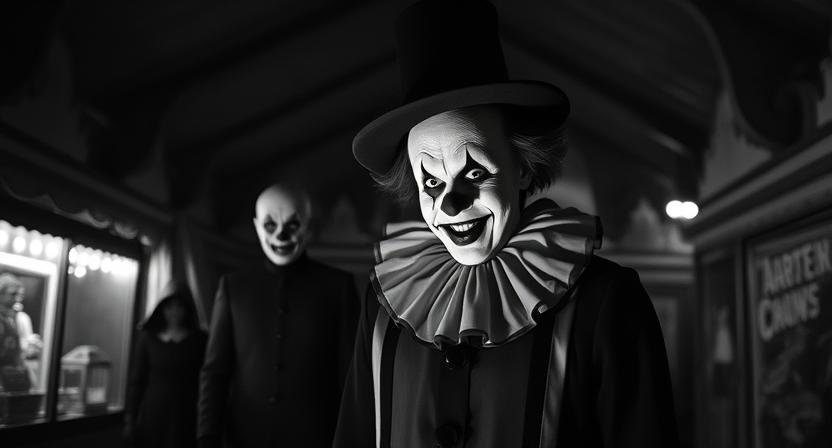Art the Clown stands as one of contemporary horror cinema’s most distinctive and unsettling antagonists. This silent, theatrical killer has carved out a unique niche in the horror genre, combining classic clown imagery with extreme violence and psychological terror. Unlike traditional horror villains who rely on supernatural powers or elaborate backstories, Art’s horror stems from his unpredictable nature and theatrical presentation of violence.
Table of Contents
The Origins and Creation of Art the Clown
Early Development
Art the Clown first appeared in creator Damien Leone’s short films before evolving into the central figure of a horror franchise. The character’s design draws inspiration from classic mime performers and vintage clown aesthetics, but twists these traditionally entertaining figures into something deeply disturbing. Leone’s vision was to create a villain who could be both comedic and terrifying, using the inherent uncanny valley effect that many people experience with clown imagery.
Character Design Philosophy
The visual design of Art the Clown is deliberately unsettling. His stark black and white costume, exaggerated facial features, and mime-like movements create an otherworldly presence. The character’s silent nature adds to his mysterious and unpredictable quality, forcing audiences to focus on his physical expressions and actions rather than dialogue or monologues that might humanize him.
Art the Clown in Cinema
Film Appearances and Evolution
Art the Clown has appeared across multiple films, with each iteration building upon the character’s mythology and expanding his presence in horror culture. The character’s progression through different films shows an evolution in both presentation and the scope of his terrorizing activities. Each appearance has contributed to building a comprehensive portrait of this silent killer while maintaining the mystery that makes him effective as a horror antagonist.
Cinematic Impact and Techniques
The films featuring Art the Clown employ various cinematic techniques to maximize the character’s horrifying impact. The use of practical effects, careful lighting, and sound design creates an atmosphere where Art’s presence feels both theatrical and genuinely threatening. The character’s movements are choreographed to be simultaneously graceful and menacing, playing on the audience’s expectations of clown behavior.
Psychological Horror Elements
The Fear of Clowns (Coulrophobia)
Art the Clown taps into coulrophobia, the widespread fear of clowns that affects a significant portion of the population. This fear often stems from the disconnect between a clown’s intended purpose (entertainment and joy) and their actual appearance (masked identity and exaggerated features). Art amplifies these unsettling elements by combining them with violent behavior, creating a perfect storm of psychological discomfort.
Silent Terror and Non-Verbal Communication
The character’s muteness serves multiple psychological functions. Without dialogue, audiences cannot predict Art’s intentions through verbal cues, making his actions seem more random and therefore more frightening. His reliance on physical expression and gesture creates a more primal form of communication that bypasses rational thought and speaks directly to instinctual fears.
Cultural Impact and Reception
Horror Community Response
Within horror communities, Art the Clown has generated significant discussion and analysis. Fans appreciate the character’s commitment to practical effects and old-school horror techniques in an era dominated by digital effects. The character represents a return to visceral, in-your-face horror that doesn’t rely on jump scares or supernatural explanations.
Critical Analysis and Interpretation
Critics and horror scholars have examined Art the Clown as a representation of various societal fears and anxieties. Some interpret the character as a commentary on the corruption of innocence, while others see him as embodying fears about anonymous violence in modern society. The character’s theatrical nature also invites analysis about the relationship between performance and violence.
Technical Aspects of the Character
Makeup and Costume Design
The creation of Art the Clown’s appearance involves intricate makeup work and costume design. The stark black and white color scheme creates a timeless quality that prevents the character from being tied to any specific era. The makeup application process transforms the performer into something that appears almost inhuman while maintaining enough human characteristics to remain relatable as a threat.
Performance and Physicality
Bringing Art the Clown to life requires specific performance skills that blend mime work, dance, and acting. The performer must convey complex emotions and intentions through physical movement alone, making the role particularly challenging. The character’s movements are carefully choreographed to be both elegant and disturbing, requiring significant physical control and awareness.
Art the Clown’s Place in Horror History
Connection to Classic Horror Traditions
Art the Clown connects to a long tradition of theatrical horror villains while bringing unique elements to the genre. The character shares DNA with classic movie monsters but updates the concept for contemporary audiences. This blend of old and new makes Art both familiar and fresh, appealing to longtime horror fans while attracting new audiences.
Influence on Contemporary Horror
The success of Art the Clown has influenced other horror creators to explore similar approaches to villain creation. The character demonstrates that effective horror antagonists don’t necessarily need complex backstories or supernatural powers to be effective. Sometimes, the most terrifying villains are those whose motivations remain completely mysterious.
Behind the Scenes: Creating the Character
Collaboration and Creative Process
The development of Art the Clown involves collaboration between writers, directors, makeup artists, and performers. Each contributor brings expertise that helps refine the character’s presentation and impact. This collaborative approach ensures that every aspect of the character, from visual design to movement patterns, works together to create maximum effectiveness.
Challenges in Performance
Performing as Art the Clown presents unique challenges for actors. The lack of dialogue means that all communication must be visual, requiring heightened physical performance skills. The costume and makeup can also be physically demanding, requiring performers to work within significant constraints while maintaining the character’s distinctive movement style.
The Future of Art the Clown
Continuing Evolution
As the character continues to appear in new projects, Art the Clown continues to evolve while maintaining his core characteristics. Future appearances may explore new aspects of the character or place him in different contexts, but the fundamental elements that make him effective are likely to remain constant.
Legacy and Lasting Impact
Art the Clown has established himself as a significant figure in contemporary horror cinema. The character’s unique approach to horror, combining theatrical presentation with violent action, has created a template that other creators may follow or react against. Regardless of future developments, Art has already secured his place in horror history as a distinctive and effective antagonist.
Frequently Asked Questions
Q: What makes Art the Clown different from other horror movie clowns? A: Art the Clown is distinguished by his complete silence, theatrical presentation, and emphasis on practical effects. Unlike other horror clowns who often speak or have clear motivations, Art remains mysterious and unpredictable throughout his appearances.
Q: Why doesn’t Art the Clown speak? A: The character’s muteness is a deliberate creative choice that adds to his mysterious and unpredictable nature. Without dialogue, audiences cannot predict his intentions, making him more frightening and allowing his physical performance to take center stage.
Q: Is Art the Clown based on any real person or historical figure? A: Art the Clown is an original fictional character created by Damien Leone. While the design draws inspiration from various clown and mime traditions, the character is not based on any specific real person.
Q: What is the significance of Art’s black and white costume? A: The stark black and white color scheme creates a timeless, almost ethereal quality that makes Art appear otherworldly. This design choice also helps the character stand out visually and adds to his theatrical presentation.
Q: How has Art the Clown influenced modern horror? A: Art the Clown has demonstrated the effectiveness of practical effects and physical performance in horror, influencing creators to focus on visceral, theatrical approaches rather than relying solely on digital effects or supernatural elements.

